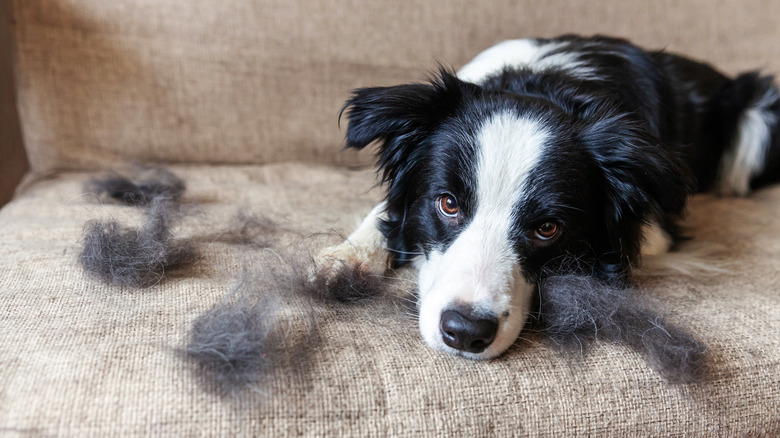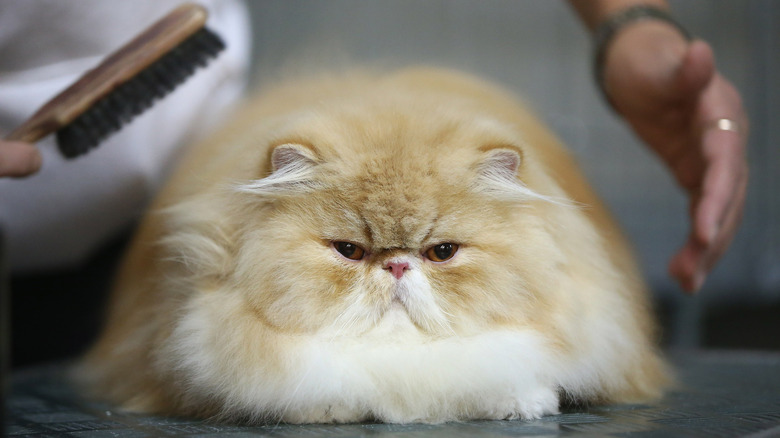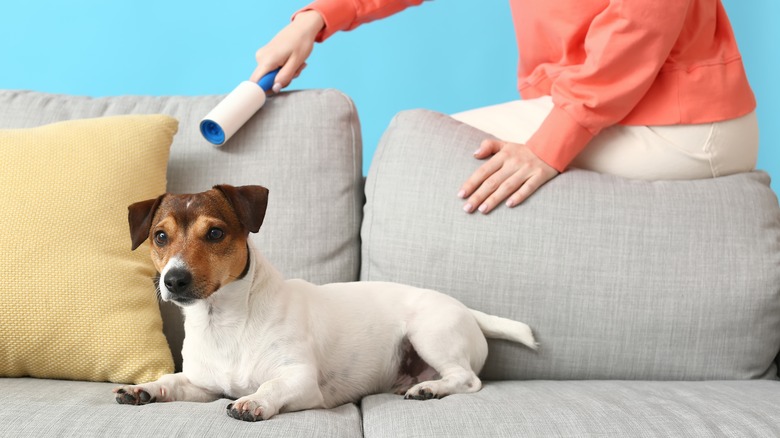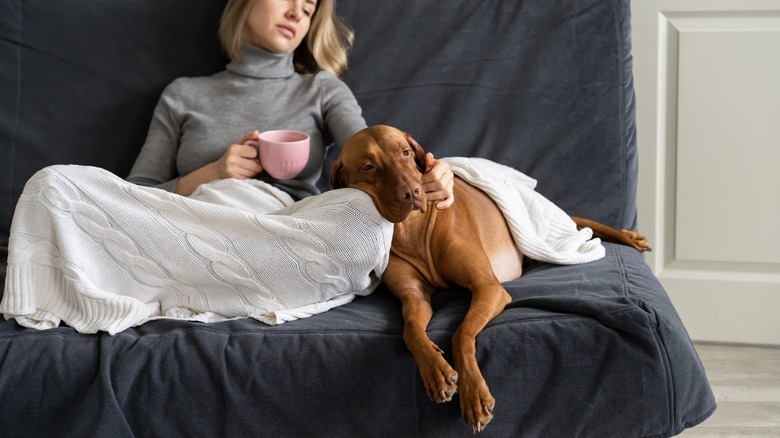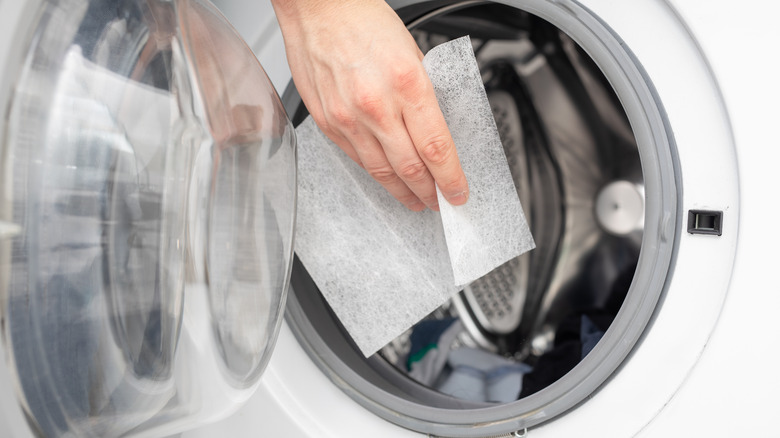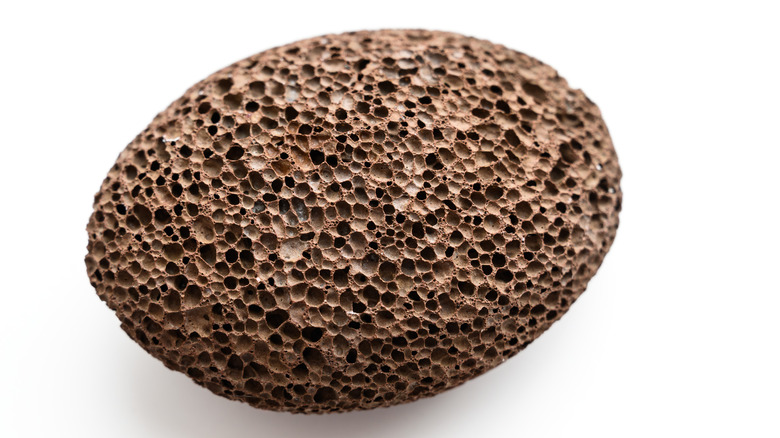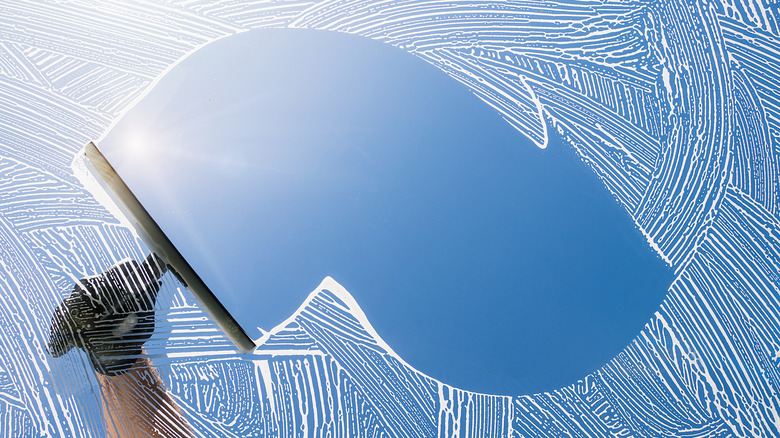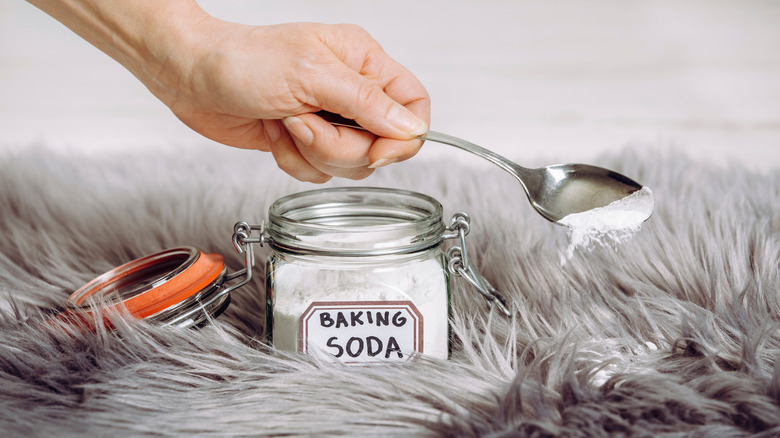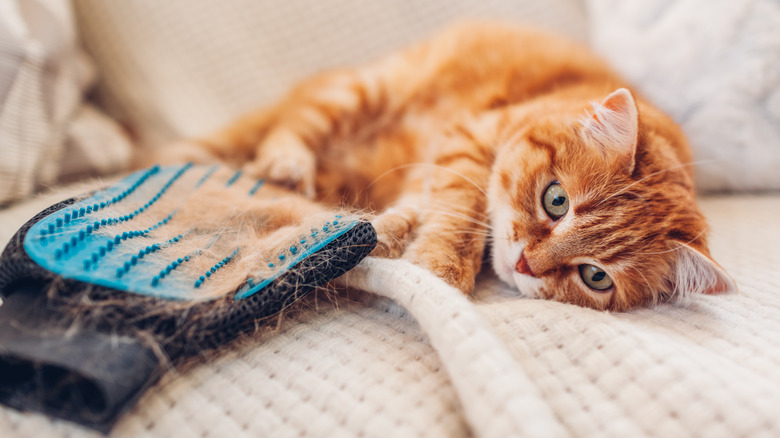8 Ways To Get Rid Of Pet Hair In Your Home
We all love our pets, but what we don't love is the fur they constantly leave behind. Think of all the black pants you've sacrificed while cuddling up with your fur baby. No matter if you have a cat or dog, you may have noticed your pet sheds more in the spring and summer time. This excessive shedding happens in the warmer months as a way for your animal to get rid of its heavy winter coat in order to stay cool, says Academy Animal Hospital.
If you have a pet (which we're assuming you do since you're reading this article), you know that getting rid of pet hair in your home can sometimes be difficult and is usually annoying. Fortunately, ridding your home of pet hair doesn't have to be a long process. Depending on the surface area and the thickness of the fur, clean up should take about 20 minutes at most. If you've been putting off cleaning and the pet hair has really piled up, it may take you a bit longer.
1. Regularly brush your pets
No matter how hard you try, you can't stop your pet from shedding; it's just a part of life. You can, however, reduce the amount of shedding by regularly brushing your pet. Elliot's House Pet Care says brushing helps to collect excess fur that would otherwise end up all over your furniture and clothes. Regularly brushing your four-legged friend not only cuts down on shedding, it also improves their coat, making it shinier and softer.
When it comes to pet grooming tools, there isn't much difference between a cat brush and a dog brush. So if you're lucky enough to have both in the house, feel free to groom them with the same brush or comb. If one pet has thicker fur or it gets tangled easily, however, it's important you get the correct brush to avoid any discomfort while grooming, says Pawscessories. Once you have the proper tools, try to keep a daily brushing routine to avoid spreading that unwanted pet hair.
2. Lint roller
Despite its name, a lint roller does more than remove that pesky lint from your favorite shirt. With just a few rolls back and forth, you can use this simple tool to get rid of the pet hair that's been collecting on your furniture. There are pet-specific models on the market, but any lint roller will do. The great thing about lint rollers is they are typically inexpensive, so you won't have to shell out a bunch of cash each time you need a replacement.
It might seem silly, but you can even lint roll your pet between brushings, says First For Women. While it doesn't replace an actual brush, using a lint roller reduces the amount of shedding and even hairballs in cats, which can cause your pet a great discomfort. Just remember to be extra gentle when lint-rolling your fur baby (and that we are not responsible for any barking or hissing that may occur).
3. Slipcover
Have you ever walked into someone's home, sat on their couch, and thought, "Why is this couch so squeaky?" Then, after looking down you noticed you were sitting on a slipcover? Slipcovers are used to prevent spills, rips, and other household disasters. If that person had a pet, chances are, they were also trying to keep their couch from becoming a giant fur ball.
With advances in the industry, slipcovers are no longer just the thick plastic your grandmother used to use. Now they're available in a variety of fabrics, but for pets Home Advisor suggests one made of microfiber cloth. This fabric is easy to clean because it doesn't tear, so you can vacuum away the pet hair without causing any damage to the couch. For extra pet messes, you can treat stains with soap and warm water. If you have pets but aren't interested in slipcovers, keep an eye out for microfiber upholstered furniture next time you're shopping for a new couch.
4. Tumble dry your bedding
So, you've covered your couches and chairs with slipcovers, but what about your bedding and favorite blankets? You've tried washing them, but they still come out covered in pet hair! Next time, before you wash your bedding, Speed Queen recommends placing your comforter and bed sheets in the dryer for 10 minutes on tumble dry, no heat. Doing this before you put these items in the wash will help loosen the pet hair from the fabric, which ultimately gets stuck in the dryer's lint trap. If your bedding doesn't require a full wash cycle, just toss it in the dryer to remove the pet hair and you're good to go.
You can do the exact same thing for your pet's bed as well. For this, Speed Queen suggests stopping the cycle halfway to clean the lint trap so it doesn't get clogged. A clogged lint trap is essentially useless, and you'll end up with the same hairy bed you started with.
5. Pumice stone
Pumice stones are commonly used for foot care, but they're also a great resource for removing pet hair from your home. If your cat or dog has a favorite spot in the house where they like to relax, that area is probably caked with pet hair. It's even more likely the pet hair is matted into the carpet. When this happens, it's almost impossible to remove with a vacuum, says USA Today. In this case, try using a pumice stone to lift it up and out.
To use the pumice stone, simply scratch it over the affected area and you'll notice the hair start to lift from the carpet. This is because of the stone's rough surface. This method is similar to using a pumice stone to remove dry skin from your body. It's essentially exfoliating the carpet, loosening all the hairs that are trapped in its loops.
6. Squeegee
Squeegees aren't just for car windows and bathroom mirrors anymore. Today's Homeowner says you can actually use a rubber squeegee on your furniture and carpet to get rid of pet hair in your home. You can either use the squeegee as it comes (with a short handle), or attach the rubber head to a mop handle for a longer reach.
Pull the rubber side of the squeegee across the carpet like a rake and watch as the pet hair lifts from the carpet fibers. Think of it as raking your front yard to collect leaves. A standard-sized squeegee is absolutely fine to use, however, if you want to do double the work in half the time, use a larger squeegee to cover more surface area. When you're finished, simply pick up the clump of collected pet hair and throw it away, or give your carpet a once-over with the vacuum to grab any hairs you may have missed.
7. Baking soda
Baking soda is an excellent and inexpensive way to get rid of pet hair in your home, says Pet Keen. It helps loosen the hairs, making it easier to remove from the loops in your carpet. To use on your carpet, sprinkle a generous amount of the baking soda throughout, let it sit for 15 minutes, then vacuum the floor. You can use this same method for your furniture. Again, simply sprinkle the baking soda on your couch cushions, let it sit, then vacuum using the upholstery attachment.
As an added bonus, baking soda helps eliminate odor. According to House Logic, unlike your household air fresheners, baking soda actually absorbs the smell, whereas air fresheners simply mask it. Because of this, you've probably noticed a lingering odor when using an air freshener. If you notice your house has a stronger pet odor, let the baking soda sit on your carpet or furniture for even longer.
8. Rubber glove
Using rubber gloves to get rid of pet hair is all about chemistry. Apartment Therapy explains that rubber attracts hair using static electricity. Essentially, the rubber glove works as a conductor that collects the pet hair. To create static electricity, put on a rubber glove and rub your hands all over your furniture and carpet. This causes friction between the two, allowing the hair to stick to the rubber glove.
Apartment Therapy also suggests simply wetting the rubber glove and running your hand over the pet hair. The fur will stick to the glove which you can then rinse off in the sink. If you want to get fancy, you can find a pair of rubber gloves with built-in bristles to run across your furniture. This will ruffle up any hairs that might be trapped in the fabric. This method works for more than sofas and chairs. You can use it for smaller upholstered areas as well, such as curtains and lampshades.
